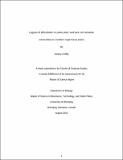Legacies of afforestation on prairie plant, seed bank, and nematode communities in a northern rough fescue prairie
Metadata
Show full item recordAuthor
Coffey, Victory
Date
2018-08-31Citation
Coffey, Victory. Legacies of afforestation on prairie plant, seed bank, and nematode communities in a northern rough fescue prairie; A thesis submitted to the Faculty of Graduate Studies in partial fulfillment of the requirements for the Master of Science degree, Department of Biology, Master of Science in Bioscience, Technology, and Public Policy, University of Winnipeg. Winnipeg, August 2018.
Abstract
Afforestation resulting from fire suppression, modified grazing, plantation establishment and climate change poses a threat to northern prairie ecosystems. Trees alter the composition and function of plant and soil communities and can compromise the restoration of afforested prairies. To evaluate the hypothesis that legacies of afforestation persist in restored prairie communities above and belowground and decrease the potential for restoration, I examined the composition, structure, and diversity of plant, seed bank and soil nematode communities along a 20 year chronosequence of plantation tree removal in a former rough fescue prairie. Study sites were located within two historic white spruce (Picea glauca) plantations established between 1930 and 1940 on rough fescue prairies in Riding Mountain National Park, MB, Canada. Within each site, I compared plant, seed bank, and soil nematode communities between areas of native prairie, remaining plantation stands, and three tree removal treatments (2, 5, and 20 years old). Tree removal increased the abundance of weedy species in the plant and seed bank communities of restored prairies and overall diversity was lowest 20 years after tree removal, never reaching the levels of diversity observed in the native prairie. Shifts in plant community structure were accompanied by shifts in nematode feeding groups, with fungal and bacterial feeding nematodes highest in the plantation and recently restored treatments meanwhile plant parasitic nematodes dominated the oldest restored treatment and native prairie. However, unlike the native prairie, the overall diversity of the nematode community was lowest in the oldest restored treatment. Nematode community diversity and structure was strongly correlated with the composition of restored plant communities. I conclude that tree removal alone is insufficient for the restoration of northern fescue prairies and that, in the absence of active management, the assembly of low-diversity plant, seed bank, and nematode communities constitutes an important legacy of afforestation and an important barrier to future restoration.

